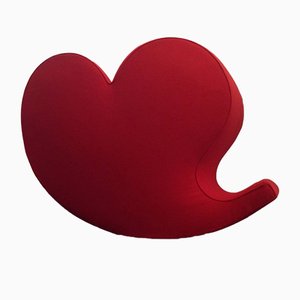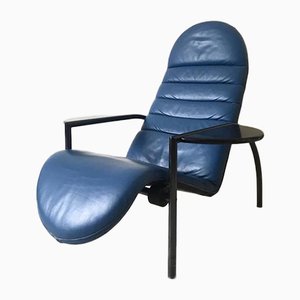A review of the decade’s most iconic chairs
Your '90s Refresher
Over the past few seasons, while the fashion world has openly re-embraced several tenants of the ’90s (minimalistic silhouettes are back in our good graces, as are bare midriffs, tough-guy plaids, and baby doll dresses and boots, as evidenced by the most recent Raf Simons and Saint Laurent shows, among others), the design world has found itself in a riotously patterned 1980s renaissance—with a special emphasis on the glory that was Memphis. And though we’ve absolutely enjoyed the ’80s ride, at this point, we’re pretty sure the ’90s design refresh is also just around the corner.
After all, in addition to the decade’s essentialist, often biomorphic, experimental forms (a direct response to the over-the-top 80s), the ’90s saw the rise of the independent designer-producer. The likes of Ron Arad, Tom Dixon, Marc Newson, the Campana brothers, and several others who are now household design names debuted internationally thanks, in large part to the efforts of a select group of key manufacturers led by visionary creative directors (and incredible talent scouts) such as Giuilio Cappellini, Patrizia Moroso, and others. These designers, who’d previously worked outside the traditional manufacturing universe—often with unorthodox materials and processes—now found themselves with the support of major brands. And the design celebrity (as much as there’s ever been one) was born.
And we’re not the only ones who think so. During a recent conversation, Mr. Cappellini told us, “The 90s represented for sure a crucial moment in the evolution of contemporary design. Yes, at the moment there is great attention on the ’80s and the Memphis phenomenon, but we will shortly relate to the nineties as a period in which designers worked—often as outsiders—by presenting their products with organic and unusual shapes and extraordinary colors.”
In anticipation of the next “it” era comeback, we’re highlighting a few of the decade’s most iconic designs, for a proper review. Enjoy!
S Chair by Tom Dixon for Cappellini (1991)
The pioneering Dixon taught himself to weld and make furniture, and he also set up a shop and storefront in London during the ’80s for himself and other emerging designers. Cappellini championed Dixon’s work early on—as did upstart galleries like Themes & Variations—and Dixon worked with Cappellini to produce his S Chair. The famed piece features a sinuous steel frame covered in woven wicker, leather, and more.
Knotted Chair by Marcel Wanders (1996)
This small, lightweight seat married handcraft and industrial techniques. Wanders constructed a “thread” using aramid and carbon fibers, which were then knotted into the shape of a chair and hung to dry in a frame, “leaving the final form in the hands of gravity.” Today, this limited-edition beauty sits in the permanent collections of New York’s MoMA, Amsterdam’s , and London’s V&A.
Fiberglass Felt Chair by Marc Newson (1993)
Inspired by Japanese origami, the Australian designer elevated a flat piece of thick felt into curved masterpiece with his original Felt Chair in 1988. A few years later, he remade the chair with Cappellini using fiberglass.
Louis 20 by Philippe Starck for Vitra (1991)
Starck is known for his rogue approach; with Louis 20, the merry prankster—working with Vitra—expertly juxtaposed a seat and 2 legs out of blown polypropylene alongside a pair of aluminum legs.
Aeron Chair by Bill Stumpf and Don Chadwick for Herman Miller (1994)
During the early ’90s, as more people began using computers in their day to day (hello world wide web!) and average, seated office hours increased, Stumpf and Chadwick designed a chair to properly support our new habits. The duo conducted extensive consumer testing prior to debuting the adaptable and ergonomic Aeron for Herman Miller. The resulting task chair helped make the workday far more comfortable—and therefore productive—for people of all shapes and sizes. And its form—stripped down, biomorphic—was a game changer. As Stumpf noted, “The human form has no straight lines”. . . and neither does his chair.
Air Chair by Jasper Morrison for Magis (1999)
Air Chair for was one of the first instances when gas-injection technology was applied to furniture. The result was minimalistic, lightweight, stylish, and stackable—and it introduced a new level of quality to the one-piece plastic chair. As Morrison has said, “Previously, plastic chairs were only possible with single wall thicknesses and reinforcing ribs. The gas-injection technology allowed for continuously smooth surfaces."
Soft Heart by Ron Arad for Moroso (1990)
Beginning in the ’80s, Arad produced sculptural furniture out of unexpected materials—quite often, rugged metals like aluminum and steel. In the early 1990s, working with the Italian manufacturer Moroso (and creative director Patrizia Moroso), Arad realized some of his earlier, signature metal pieces—including Soft Heart—in mass-manufactured, upholstered fabrics, adding a layer of accessibility to some of his most dramatic works.
-
Text by
-
Anna Carnick
Anna is Pamono’s Managing Editor. Her writing has appeared in several arts and culture publications, and she's edited over 20 books. Anna loves celebrating great artists, and seriously enjoys a good picnic.
-
-
Text by
-
Wava Carpenter
After studying Design History, Wava has worn many hats in support of design culture: teaching design studies, curating exhibitions, overseeing commissions, organizing talks, writing articles—all of which informs her work now as Pamono’s Editor-in-Chief.
-






